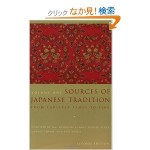Sources of Japanese Tradition Vol. 1. ed. Wm. Theodore de Bary, Donald Keene, George Tanabe and Paul Varley Columbia University Press, first published 1958; revised in 2002 524 pages
_________________________________________________________________________________________________

This anthology of significant writings in the cultural formation of the country has long been an essential item on any student of Japan’s desktop. Volume I begins with the very earliest records and covers the period up to 1600. Here we’re concerned with the sections about Shinto, which amount to about a quarter of the book. As cultural background though, you could say that the whole book is relevant in one way or another.
Chapter I consists of early Chinese accounts, such as that of the shaman-ruler Himiko, here referred to as Pimiko. Chapter 2 gives key extracts from the myths, as well as selections from early Norito prayers. Chapter 4 deals with the influence of Chinese thought on the imperial construction by reference to the preface of Kojiki and extracts from the Nihongi. Chapter 15 provides an overview of Shinto-Buddhism syncretism, together with the rise of Shinto consciousness following defeat of the Mongols thanks to the kamikaze divine wind. Japan was proclaimed a shinkoku (land of the gods).

The Mongols made two abortive attempts at invasion, in 1274 and 1281
Throughout the book are commentaries, which not only provide an informative introduction to each section but also lead into translations that are unusually clear and accessible. Unlike many books dealing with medieval matters, this one is a joy to read!
The formation of Japan
Japan came late to the written word, and the book begins with Chinese accounts of the land of Wa, as the country was then known. From these we learn that the 100 or so tribal communities of 1 BCE were reduced to some 30 by the mid-third century. Water and mountains formed the Japanese consciousness from the outset. The proto-Shinto of these times is said to consist of “a primitive and almost inarticulate group of cults”. It was not until the early eighth century that the word ‘Shinto’ was coined to describe them, as a way of distinguishing the native tradition from Buddhism.

The first recorded use of a sun-motif flag is 701 by Emperor Mommu
With the defeat of the Wajin in Korea in 562, the hegemonic Yamato state moved towards nation-building in order to compete with China and a unified Korea. Continental notions of solar worship raised awareness of the country’s location next to the Pacific, from out of which the sun rose each morning, and by 670 the name of Nippon (sun origin) is being used in print. It was at this time too that Emperor Tenmu ordered the compilation of Chinese-style histories, intended to show the divine descent of the imperial line. Kojiki (712) and Nihon shoki (720) were the result.
Shinto-Buddhist syncretism
The book is particularly good at describing how Buddhism dominated Shinto in the syncretism that characterised the classical and medieval ages. Not only were many of the country’s shrines run by Buddhist monks, but in some cases Buddhist statues served as the ‘spirit-body’ (shintai) for the kami. In 937 comes the first mention of the honji-suijaku (essence-trace) theory, by which Buddhist deities were seen as the eternal essence and kami as their localised manifestation. It meant that kami were reduced to avatars, and Buddhist priests prayed for their salvation.

A symbol of syncretism: Hachiman Daibosatsu – the kami as boddhisattva
The rise in kami awareness following victory over the Mongols led to a reaction against the Buddhist domination, which found its fullest expression in Yoshida Kanetomo’s audacious reversal of honji-suijaku. Shinto constituted the roots of the national culture, he asserted, which meant it had primacy over Buddhism and Confucianism. Kami were the real essence, Buddhist deities a mere trace!
All of this is covered by the book in systematic manner, with explanations of the medieval theorising in simple, easy-to-follow terms. The commentary is accompanied by short extracts from documents that are crucial to an understanding of the issues involved. It’s a remarkable achievement, and the book has been rightly lauded for its accomplishments. It is, quite simply, superb.
*****************************************
Verdict: An essential item for anyone seriously wanting to understand the formation of early Shinto (and of the religious and aesthetic sensibilities of Japan in general).

Leave a Reply